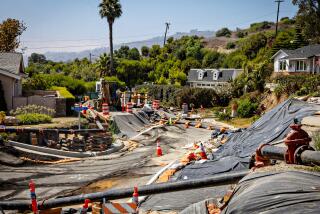Line Drawn in the Sand Over New Power Plants
Fearing the possible construction of new power plants along Ventura County’s coastline, local officials and environmentalists warned Tuesday they would fight Southern California Edison if it tries to build new generators on its beachfront property.
County Supervisor Kathy Long predicted strong opposition, adding that “years of work have gone into trying to protect these wetlands. This is some of the last remaining coastal areas in the state of California.”
Edison’s decision last week to stop its sale of 307 acres of coastal land near the Ormond Beach and Mandalay power plants to the California Coastal Conservancy dismayed environmentalists, although some said they hoped for a new deal.
“I cried a lot over the weekend,” said Roma Armbrust, an activist who has spent 13 years on the project. “I have no inside information. I can only go to bed hoping.”
As part of deregulation, the state ordered Edison in 1995 to sell its excess property. The company notified the Coastal Conservancy on Friday that it would end negotiations to sell the oceanfront parcels near the two power plants while legislators ponder a solution to the energy crisis.
It doesn’t make sense to continue the negotiations with the Coastal Conservancy during a period of uncertainty in the Legislature, said Peter M. Lersey, director of Edison’s divestiture program.
Edison, Lersey said, will decide if it can “sell to the state or a provider or to the conservancy.”
The Legislature and Gov. Gray Davis last week approved the sale of $10 million in bonds so the state can enter the energy business to assure a stable, affordable supply of electricity.
Building a new power plant would be more lucrative for Edison than selling the land to the Coastal Conservancy for the $15 million on the table. But air quality and environmental rules may still make it hard for Edison or another company to build new power plants along the coast.
Sara Wan, chairwoman of the state Coastal Commission and a board member of the Coastal Conservancy, said the commission would have little role in any planned power plant construction. But, she said, she will ask the Legislature and governor to persuade Edison to go through with the original conservancy sale.
“The odds are probably nil to nothing” of that happening, Wan said, “but I can hope.”
Several environmentalists mentioned Assemblywoman Hannah-Beth Jackson (D-Santa Barbara) as their best hope at stopping new plants at Ormond Beach and Mandalay. Jackson stopped short of saying she would oppose building at the two sites, but added that with generating facilities already in works, Edison might not need to build at either site.
“The state of California has already destroyed 95% of our wetlands,” Jackson said. “If this was the only place in California where we could site a plant, that’s one thing. . . . If there were better places, we should consider those first.”
Jackson, a member of the Assembly Committee on Energy Costs and Availability, said the state needs more power, but “the answer isn’t necessarily build, build, build.” A rash of plant construction could flood the state with a glut of electricity, she said.
Long said Edison’s decision comes too late.
“The work done for the conservation, the protection of these 307 acres is too valuable and too far down the road for . . . Edison to threaten to back out of the deal,” she said.
By pulling the Ormond Beach property off the market, Edison delays a 1,404-acre planned community north of Ormond Beach, supported by city officials as a way to revive beleaguered south Oxnard while preserving hundreds of acres of wetlands.
Even if Edison doesn’t sell to the conservancy, the development could still survive, said Curtis Cannon, Oxnard’s redevelopment director.
“It doesn’t mean we won’t pursue a wetlands restoration project, whatever gets done,” he said. “The conservancy was a hope because they have a pot of money. It’s back more on the shoulders of the city, in conjunction with the developer.”
The Coastal Conservancy is a state agency established by the Legislature in 1976, meant to secure environmentally sensitive land as open space. The agency recently received nearly $250 million in land-acquisition funds from Propositions 12 and 13.
Other officials hoped that political repercussions of building in a wetland might be enough to make Edison reconsider if it chose to go ahead.
“My hope, and I think reasonable expectation, when things do calm down a little is that Edison will be comfortable with the feeling that neither they nor anyone else is going to build a power plant in a wetland,” said Steve Kinney, president of the Greater Oxnard Economic Development Corp.
*
Times staff writer Tina Dirmann contributed to this story.
More to Read
Sign up for Essential California
The most important California stories and recommendations in your inbox every morning.
You may occasionally receive promotional content from the Los Angeles Times.










